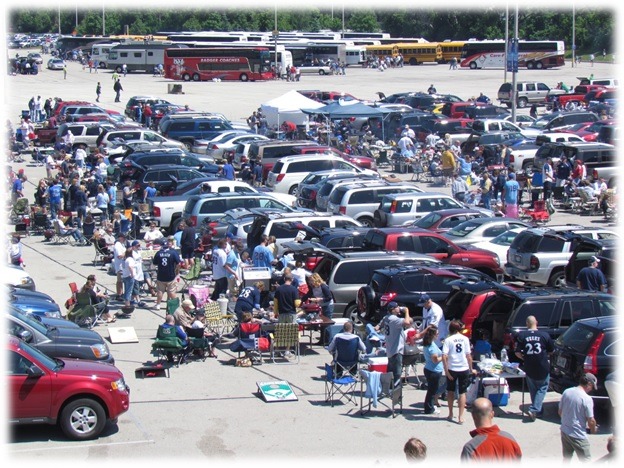As we approach March Madness and the blessed start of the 2014 Major League Baseball season, many Sports Radio stations and they DJs may actually have something to talk about after a long winter.
And like many fans of sports and radio, I always enjoy studying what happens on the courts, fields, and diamonds to draw analogies to the world of broadcasting. Of course, all sports are businesses from the NBA to the NCAA to the Olympics, and that’s why we shouldn’t be surprised that there’s an event called the MIT Sloan Sports Analytics Conference for those who love their metrics.
 No, I didn’t attend, but blogger Bruce Temkin (pictured), co-founder of the Customer Experience Professionals Association, showed up and wrote a great analysis about this event. And it’s oozing with cautionary tales, new ideas, and metaphors for radio.
No, I didn’t attend, but blogger Bruce Temkin (pictured), co-founder of the Customer Experience Professionals Association, showed up and wrote a great analysis about this event. And it’s oozing with cautionary tales, new ideas, and metaphors for radio.
Bruce has twenty takeaways from this two-day event, and I’ve taken the liberty of cherry-picking some favorites. So here goes:
1. The fan experience is something that many teams are pursuing. Temkin tells us that teams are looking to integrate mobile in many different places, including finding the concession stands and bathrooms with the shortest lines. You have to love that idea. And then the Miami Dolphins realize that different types of fans are looking for different experiences – even with tailgating. So they’re studying Premium Tailgating, Family Tailgating, and other options for groups of fans.
For radio, this is a natural, because audiences are clearly stratified in many different ways, and a one-size-fits-all approach goes against the customized, personalized trend that has become common in both technology and entertainment. We have a client that offers fans different texting databases to choose from – concert tickets, movies, etc., because not everyone enjoys the same events.
The other development was discussed by the Sacramento Kings – an idea to use GoPro cameras to take fans to places in the stadium they rarely get to see – the tunnel, by the dancers, and in other places that can provide “backstage moments.”
We’ve talked about this a lot for radio – the need for webcams to enhance the radio fan’s experience. This is especially the case for big morning and personality shows where fans want to watch the show and not just listen to it. I know DJs and teams cringe every time I suggest it, but if you’re looking for a way to turbocharge your show and provide a unique fan experience, taking them backstage and behind the scenes can be a great way for a big show to get bigger.
But the “umbrella issue” is that radio has to join the rest of the entertainment world and get serious about the user experience – or as they might call it in sports – the “Fan Experience.” Maybe FX takes on a whole new meaning, but this is an area where radio sadly lags. Maybe by giving it a brand name, we can elevate its importance because as consumers continue to become more aware of their options, the FX becomes even more critical to retaining them and generating loyalty.
2. Coaches tend to be control freaks. Temkin reports that statistician guru Bill James talked about how coaches “tend to overuse strategy to give them the illusion of control” and that the great ones have the ability to take advantage of chaos.
Sound like any program directors you know? Using the available metrics from Nielsen and other sources is a way to help guide and manage the DJs – as well as sales and even management. But at the heart of it, the best PDs – like great coaches – thrive on truly being in the moment, as well as capitalizing on those crazy local events where a market emergency or a major concert or event provides an opportunity to create radio magic – and ratings. The great station and outstanding personalities always have a way to capitalize on the chaos or buzz of the moment, keeping them current, topical, and vital.
3. Mobile, mobile, mobile. You shouldn’t be surprised that this takeaway caught my eye, but at this MIT Sloan event, teams and leagues are looking for more than just creating basic, branded apps. Again, it goes back to the fan experience. To get a sense for how big mobile has become to sports, Ticketmaster North America’s President Jared Smith talked about how half of their online traffic and now 10% of their sales are mobile based. And three in ten fans are interacting with social media while watching games, and this: half of all TV-related tweets are connected to sporting events.
We continue to see the importance of Twitter and real-time social media in the Sports section of our Techsurveys, and this year’s will be no exception. The importance of fan acknowledgment in the social space has never been more important. Finally, there’s a way to connect with fans that has nothing to do with call-in shows.
In thinking about mobile in the broadest sense for radio, the industry’s track record has been spotty. Some companies are tethered to their “umbrella apps,” but that spells opportunity for many medium and smaller broadcasters to “out mobilize” the giants by creating their own branded apps.
And then thinking about the conversation at this MIT Sloan conference, the idea of specialty apps – games, ski reports, local music and events – that enhance the FX and build brands is something that very few radio broadcasters are doing in the mobile space. Just as it is for the sports industry, mobile is a mega-opportunity for radio to create brand equity and to make money.
 4. From the lips of Stan Van Gundy… You may remember that Van Gundy used to coach the Orlando Magic and is the brother of Jeff. He’s a very quotable guy, and one of his nuggets jumped out at me about coaching:
4. From the lips of Stan Van Gundy… You may remember that Van Gundy used to coach the Orlando Magic and is the brother of Jeff. He’s a very quotable guy, and one of his nuggets jumped out at me about coaching:
“If you’re using analytics instead of watching film, then you’re making a mistake.”
In radio, the this is a common tendency – over-relying on Nielsen and even Miller Kaplan reports to get a sense for what’s truly going on at your station. There’s no substitute for listening to your station every chance you get. That’s where you hear the truth that isn’t in the Media Monitors’ squiggly lines. And on the sales side, if you show me your impressive quarterly results, I’ll ask you how well your sales staff is meeting the needs of your clients, offering them the full power of your station – on-air and online – and producing true, measurable results. An over-emphasis on the numbers is often an excuse for not managing your brand.
5. Analytics matter. It may seem like a contradiction to the aforementioned Van Gundy slap, but many conference participants – including the world-famous numbers cruncher and analyst Nate Silver – recommend more metrics – especially proprietary information. While sports teams have different economic models than radio groups and clusters, it’s interesting that Bryan Colangelo (former GM of the Toronto Raptors and son of Jerry) suggests that teams spend as much as $250,000-500,000 a year on metrics.
Maybe in radio dollars this might net out to what many radio brands are already spending a year on perceptuals, music tests, and of course, ratings. But keep in mind the importance of research that is commissioned specifically for teams – and not commonly shared. That’s where they wield that special edge.
While its essential that most stations buy ratings in order to keep track of where they are in “the standings,” the need for research that helps guide strategies has never been more important. And not just measuring music preferences, DJ awareness, and who wins the “more music” image. Understanding how each brand now competes in the larger audio ecosystem is something that every station and every company needs to address.
Maybe you’ll see other great takeaways from Temkin’s summary of this event. One that I omitted is that “Shaq was a bit of a slacker.” I thought about major DJs I’ve known over the years who haven’t exactly had the best work ethic and tended to get by on their personality and charm. But I thought better of it. By the way, by all reports, Kobe is a hard worker and that may have been at the root of his differences with Shaq.
Now if that doesn’t sound like a radio station, I don’t know what does.
- What To Do If Your Radio Station Goes Through A Midlife Crisis - April 25, 2025
- A 2020 Lesson?It Could All Be Gone In A Flash - April 24, 2025
- How AI Can Give Radio Personalities More…PERSONALITY - April 23, 2025





This is one of your best blogs ever. There is so much here – and radio’s opportunities seem so much more analogous to a sports franchise than any other – right down to the term fan experience (vs. user experience).
That said, radio has cut and consolidated out so many way that they could use to connect with fans.
I wonder that a gopro tour of a radio station in a medium market might include…
A shot of their automation system and its blinking LEDs. Then a trip to some old PC with a Pentium sticker to watch an hourly employee manually download syndicated programming from an FTP server (because the station can’t pay for the $200 program that does it automatically). From there, the camera would move to another old computer where the PD opens the email from the format captain who tells him/her what songs to add/drop this week. And now we move on to the sales department where the sales manager informs the sales staff that there will be sales meetings every day at 8AM and 5:30 PM until they hit budget.
My point is that a lot of the magic that used to be part of radio is gone – so much of it is fabricated, done remotely or gone that looking behind the scenes would be real buzzkill for the fans of most stations. And its interesting how radio has reacted to increased competition and tighter ad budgets by eliminating a lot of the potential fan experience touch points and is treading water, while sports franchises have expanded them and continued to grow – and some of that growth has probably come directly from radio. If anyone in radio doubts that they compete for the same money, take a walk around an arena and look at the walls. How many of those advertisers does radio get? How much of it did radio used to get?
For enough money, a lot of teams will include a seat on the team plane or dinner with some of the players. What comparable experience can radio offer? A seat at the Prophet unit? An email from Ryan Seacrest that begins, “Dear Valued advertiser…”?
Just sayin…
There’s no doubt that the “show” has left the business for many brands – but there are at least a few in most markets that can offer a better FX. And you have to wonder if some of these stations better utilized their assets to create better fan experiences (like how the sports franchises are thinking about it), it might not become contagious. The “lemming effect” of radio works both ways. For the past two decades, it has helped foster and justify the environment you describe (maybe not as apocalyptically grim). Why can’t it work in the reverse – those great station brands become even greater (and achieve more success) by applying some of these basic ideas? Thanks for the kind words and continuing to engage me and those read those who read this blog.
There are definitely some that still get that they’re in show business and it some or them took the leap regarding fan experience I’m sure there would be followers. One of the recurring themes of my posts here is the lack of any kind of beta testing in radio – particularly now that few companies are teetering on the brink of default. Maybe all it would take would be for some company whose name doesn’t start with a “C” to buy a bunch of radio stations.
Could be that Jerry Lee is up for it…its Thursday and I haven’t seen his name yet this week:-)
I have been remiss about omitting Jerry. I’ll work on that. You’re right about the beta testing hole – bold, innovative science experiments are things that radio should be doing.
There’s a book published by Harvard Business School Press, “Competing on Analytics” by Thomas H. Davenport and Jeanne G. Harris. It explains why the business world is turning to greater use of metrics and analytics – https://www.amazon.com/Competing-Analytics-New-Science-Winning/dp/1422103323/ref=pd_bbs_sr_1?ie=UTF8&s=books&qid=1201027928&sr=8-1
And here’s a quote from an article I wrote in 2008 “Before you discard the concept of measuring advertising response, or how quickly the world is moving into analysis and metrics, consider this one timely point: Since Bill Belichick arrived as their coach, the New England Patriots have used the most detailed analytics and metrics system in sports.” (https://www.audiographics.com/agd/012208-1.htm)
I was a member of the management team that put our nation’s 4th sports talk radio station on the air in 1990, I dealt with Bill Belichick when he was coach of the Cleveland Browns. No one should doubt he’s a winner who works off gut instinct, but he depends on metrics to make decisions that come from his gut.
Your words above are apropos.
Science + gut is what makes a great coach – or PD. Thanks for your comment, Ken.